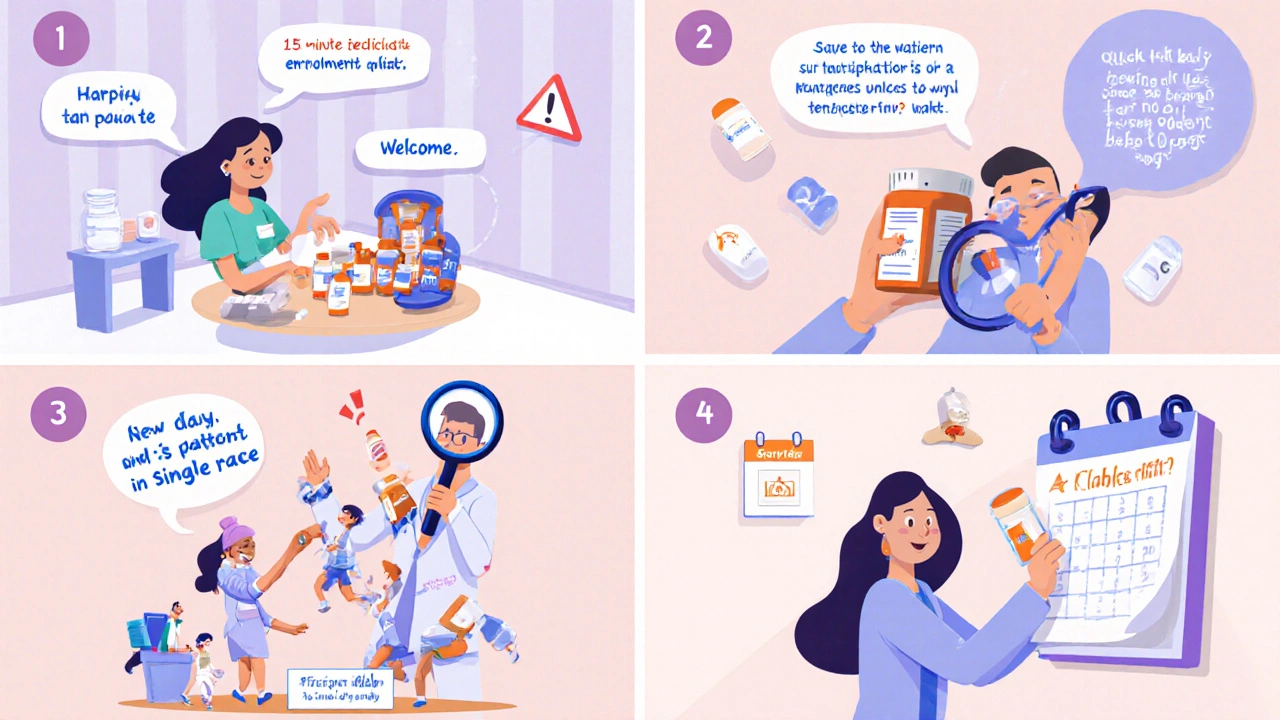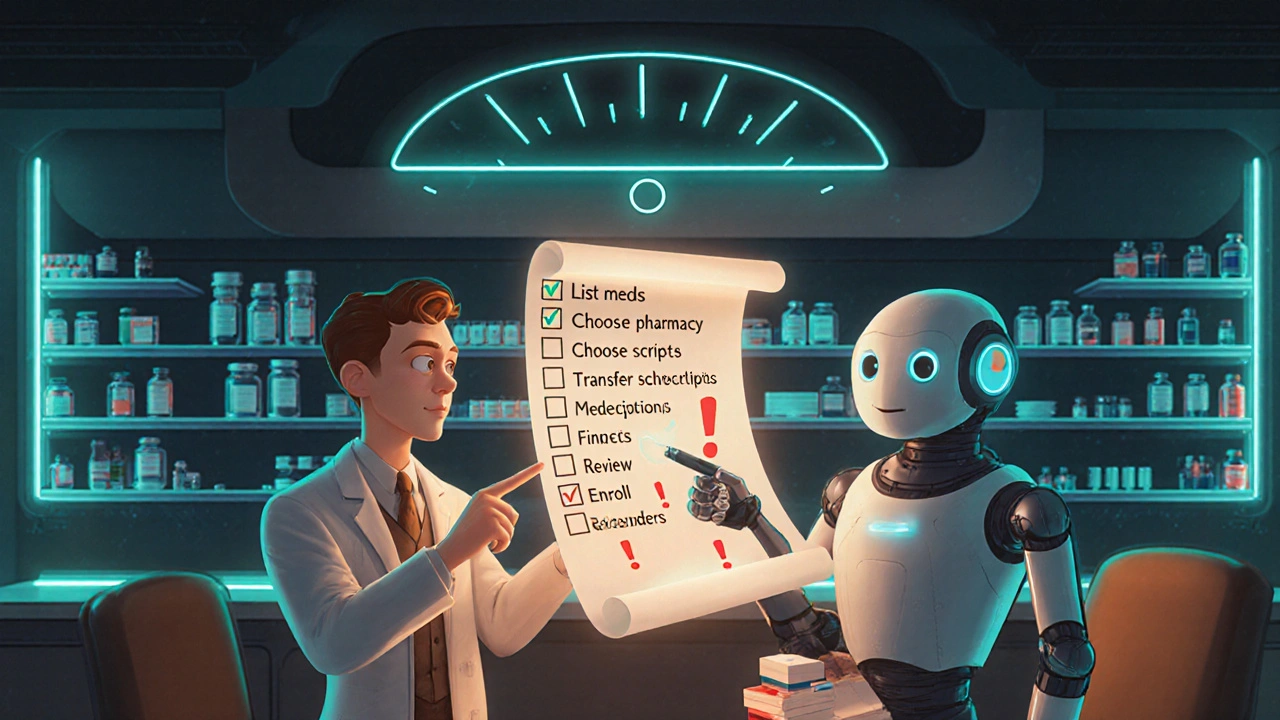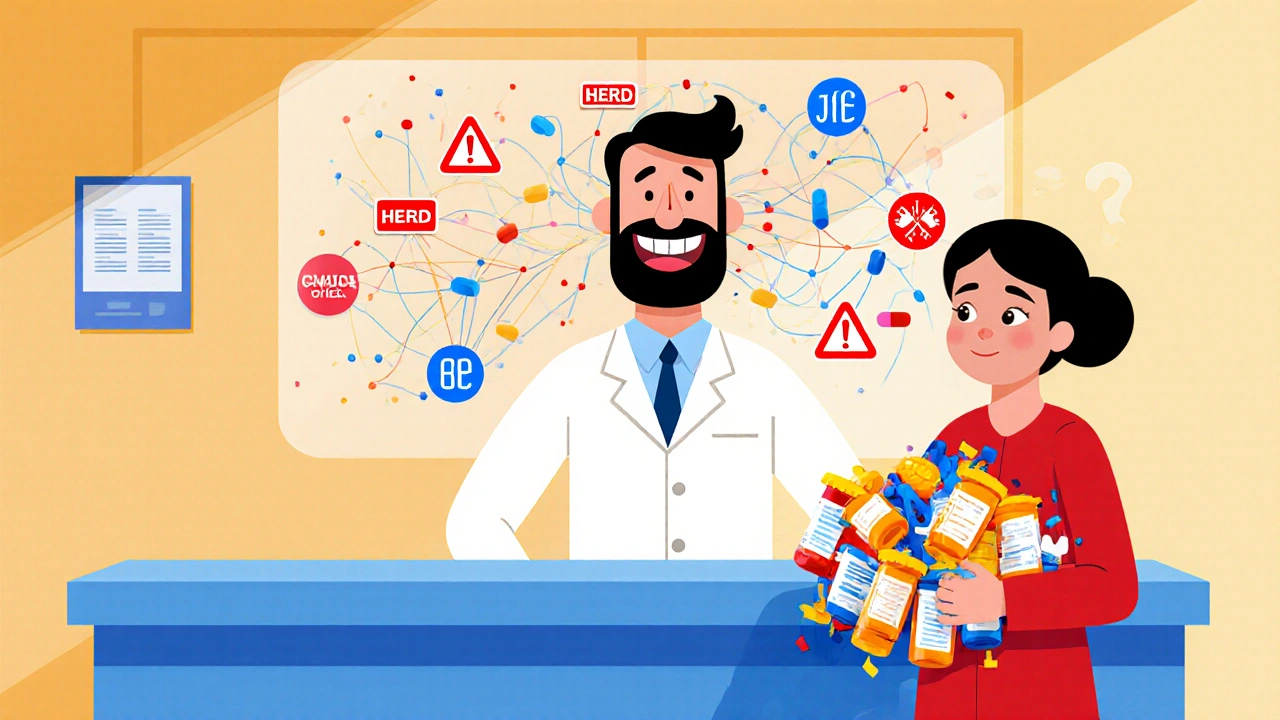Medication Safety Calculator
Your Medication Safety Assessment
See how your pharmacy habits impact your medication safety based on real research data
Your Safety Profile
Based on your inputs and published research data
Drug Interaction Risk
Single pharmacy: 6.2% | Multiple pharmacies: 8.3%
Therapy Duplication Risk
Single pharmacy: 0.3% | Multiple pharmacies: 7%
Medication Adherence
Single pharmacy: 89% | Multiple pharmacies: 61%
Potential Hospitalization Avoidance
Single pharmacy: 12 | Multiple pharmacies: 4
When you keep every prescription at the same pharmacy, you give the pharmacist a full picture of what you’re taking. That bird‑eye view cuts down on dangerous drug‑drug interactions, avoids duplicate therapy, and makes refill schedules a breeze. Below is a practical guide that shows how a single‑pharmacy approach works, why the data backs it up, and what steps you can take to make it happen.
Why a Single Pharmacy matters for safety
Single Pharmacy Coordination is the practice of filling all prescriptions at one pharmacy, allowing pharmacists to monitor the entire medication regimen in real‑time. This simple change tackles three big risks that come with polypharmacy:
- Drug‑Drug Interaction Screening identifies harmful combinations using automated alerts before the medication leaves the shelf.
- Therapy Duplication prevents patients from taking two drugs with the same active ingredient, a problem seen in about 7% of multi‑pharmacy users.
- Medication Adherence improves when refill dates line up, reducing missed doses.
Research shows that patients who juggle multiple pharmacies face a 34% higher chance of an interaction (Kanaan et al., 2014). The classic warfarin‑NSAID combo, for example, is five times more likely to cause serious GI bleeding when the pharmacist can’t see the full drug list.
How medication synchronization works
Medication Synchronization is a structured program that lines up all refill dates to a single monthly pick‑up and typically follows four steps:
- Enrollment - a quick 15‑minute chat to get consent and gather a complete medication list.
- Comprehensive medication review - the pharmacist checks each drug for interactions, duplicates, and dosing issues (30‑45 minutes).
- Short‑fills - small interim prescriptions are issued to bring every medication onto the same schedule (1‑2 weeks).
- Monthly pick‑up - patients collect all meds on the same day, often with a reminder call or app notification.
Chains like CVS and Walgreens report 85‑90% adherence rates once the program is in place, and patients typically notice fewer missed doses within the first month.
Hard data: safety and adherence gains
Below is a side‑by‑side look at what happens when you stick with one pharmacy versus spreading prescriptions across several:
| Metric | Single Pharmacy | Multiple Pharmacies |
|---|---|---|
| Potential drug‑drug interactions | 6.2 % of patients | 8.3 % of patients |
| Therapy duplication | 0.3 % | 7 % |
| Medication adherence (monthly pick‑up) | 89 % | 61 % |
| Average annual cost saving (excluding drug price shopping) | $0 (baseline) | $150‑$300 saved via price‑shopping |
| Hospitalizations avoided (per 1,000 patients) | 12 | 4 |
Each prevented adverse drug event saves roughly $8,750 in hospital costs (AHRQ, 2022), so the safety payoff quickly outweighs modest price differences for most people.

Balancing cost and safety
It’s true that many patients use several pharmacies to chase lower prices. Consumer Reports (2022) found a typical savings of $150‑$300 a year. However, the same study notes that 27% of those patients experience a medication‑related emergency, which can cost thousands. The decision comes down to personal risk tolerance and whether you can get price discounts through a single‑pharmacy coupon program or insurance‑based formulary.
Pharmacists can help you compare out‑of‑pocket costs while keeping the full medication list intact. Some chains even offer “price match” guarantees for generic drugs, meaning you can enjoy safety without sacrificing too much on the wallet.
Implementing the switch: a step‑by‑step plan
Moving every script to one pharmacy usually takes 2‑4 weeks. Here’s a realistic timeline:
- Gather your list - write down every prescription, OTC product, and supplement you take.
- Choose a pharmacy - consider accessibility, insurance acceptance, and any existing medication‑sync programs.
- Transfer prescriptions - the new pharmacy contacts your old one; expect 2‑5 business days for each transfer.
- Schedule a medication review - a 30‑minute session with the pharmacist to catch any missed interactions.
- Enroll in med‑sync - align refill dates and set a monthly pick‑up reminder.
During the transition, keep a backup supply of critical meds (e.g., insulin, anticoagulants) to avoid gaps.
Common obstacles and how to overcome them
Patients often cite “price‑shopping” as the main barrier. Address this by asking the pharmacist about discount cards, manufacturer coupons, or bulk‑fill options. If you’re on a fixed income, a single pharmacy can actually save money by reducing duplicate doctor visits and emergency room trips.
Another obstacle is “alert fatigue.” Pharmacists receive thousands of electronic alerts each day; when they can see the whole medication profile, they are less likely to override a genuine warning. Studies show an 80% override rate when histories are fragmented, versus a 30% rate in a unified system.
For those worried about privacy, remember that the pharmacy’s medication‑history system complies with HIPAA (or GDPR in the UK) and shares data only with your consent.

Future trends: AI and integrated health records
Starting in 2023, major EHR vendors like Epic and Cerner added shared medication‑history modules that automatically push your full drug list to any pharmacy you select. By 2025, AI‑driven decision‑support tools are expected to flag not just binary interactions but also cumulative side‑effect risk scores, giving pharmacists a deeper safety net.
The 2024 CMS Part D rule proposes bonuses for pharmacies that achieve >90% medication‑sync rates, signaling that payers will soon reward the very behavior we’re describing.
Even with these tech advances, the core principle stays the same: one trusted pharmacist, one complete medication record, fewer surprises.
Quick checklist before you go
- List every drug, supplement, and OTC product.
- Pick a pharmacy that offers med‑sync and price‑match.
- Transfer all scripts (2‑5 days per pharmacy).
- Schedule a comprehensive medication review.
- Enroll in monthly refill synchronization.
- Set up reminders (text, app, or calendar).
Follow this list and you’ll cut your interaction risk by roughly one‑third while boosting adherence.
Frequently Asked Questions
Will my insurance still cover my meds if I switch pharmacies?
Yes. Most insurers allow you to choose any network pharmacy. Just make sure the new pharmacy accepts your plan and update the address in the insurer’s portal.
How long does the medication‑sync enrollment take?
The whole process - from the initial consult to the first synchronized refill - usually takes 2‑4 weeks, depending on how many prescriptions you have.
Can I still get lower prices if I use one pharmacy?
Many large chains offer price‑match guarantees, manufacturer coupons, or bulk‑fill discounts that often match the savings you’d get by shopping around.
What if I take over‑the‑counter meds or supplements?
Include them in your medication list. Pharmacists screen for interactions with OTCs and herbs just as they do with prescriptions.
Is there any risk of data breaches with a single pharmacy?
Pharmacies must follow strict privacy laws (HIPAA in the US, GDPR in the UK). Consolidating records actually reduces the number of places your data travels, lowering overall exposure.
 Oct, 24 2025
Oct, 24 2025

Ekeh Lynda
October 24, 2025 AT 15:40Having all prescriptions in a single pharmacy creates a unified medication profile that any pharmacist can review at any time. It removes the blind spots that appear when data is scattered across multiple locations. The pharmacist can instantly see a warfarin prescription alongside an NSAID and issue an alert before the patient leaves the counter. Duplicate therapy becomes evident when the same active ingredient shows up on two different labels. Adherence improves because refill dates are aligned and reminders are sent from one source. Studies show a 34 percent higher interaction risk for multi‑pharmacy users. The numbers in the table confirm that interaction rates drop from 8.3 to 6.2 percent with consolidation. Hospitalizations avoided per thousand patients rise from four to twelve when a single pharmacy monitors therapy. Cost savings on price‑shopping may appear attractive but they rarely offset the expenses of an adverse drug event. Pharmacists equipped with comprehensive medication reviews can also catch dosing errors that are otherwise missed. Automation alerts are less likely to be overridden when the full list is visible. The overall safety net strengthens as the pharmacist builds a relationship with the patient over repeated visits. Patients report feeling more confident when they know their pharmacist has the whole picture. Insurance plans are beginning to reward pharmacies that achieve high sync rates because the downstream savings are measurable. In short the data supports the practice as a low‑effort, high‑impact intervention.
Mary Mundane
October 30, 2025 AT 07:53If you don’t want the hassle, stick with the pharmacy that offers the best price match.
Michelle Capes
November 5, 2025 AT 02:46Thx for sharing, this really helps! 😊 i think adding supplements to the list is key, dont forget e.g. vitamin D.
Dahmir Dennis
November 10, 2025 AT 21:40Oh great, another miracle cure that costs nothing but our freedom. Apparently we just need to hand over our entire drug history and let the pharmacist play therapist. Sure, because we all love waiting a week for transfers and trusting a single corporate chain with every pill. The data? Yeah, let’s ignore the fact that price‑shopping can save hundreds, but hey, who cares about a few bucks when you might avoid a hospital visit. Maybe the next step is to let them choose our meals too.
Amanda Vallery
November 16, 2025 AT 16:33Most major chains already have med‑sync programs built into their pharmacy management software.
Marilyn Pientka
November 22, 2025 AT 11:26Indeed, the integration of longitudinal pharmacotherapy datasets within enterprise resource planning modules facilitates a paradigm shift towards prophylactic dispensing protocols, thereby marginalizing the antiquated notion of fragmented acquisition.